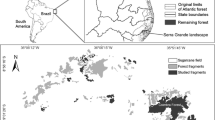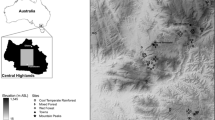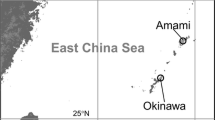Abstract
Processes involved in the structuring of forest communities include: (1) ecological sorting, where species poorly suited to local conditions are subject to environmental filtering and competitive displacement; (2) disturbance, resulting in stochastic removal of individuals and reinitiating successional regimes and (3) dispersal limitation, inhibiting the infiltration of species into preferred sites. Temporal dynamics in these processes lead to difficulty inferring causal landscape–biota correlations. Complicating factors include potential for ontogenetic variation in habitat preferences among age classes, and inherent ambiguity regarding severity and coverage of historical disturbance events. Sorting species into age groups can provide relevant temporal information. Fundy National Park is a northern, mixed-temperate forest in Atlantic Canada (Acadian forest type), which was pervasively altered upon European settlement. Species frequency data for three tree age classes (saplings, juveniles and adults) in permanent sample plots (400 m2, n = 33) were compared to environmental data, including soil chemistry, understory light conditions, physiography and disturbance history using ordination and randomization techniques. Abiotic and disturbance-related predictors of species distributions differed among life stages. Specifically, in the adult stage, stand age was a critical predictor of distribution, whereas in younger age classes environmental variables such as nutrient availability and soil moisture and drainage were key drivers of distribution. It is concluded that older populations were increasingly less constrained by environmental conditions, suggesting that adult populations bear the legacy of stochastic landscape alteration, thus appearing randomly distributed along environmental gradients. As younger populations gradually expand in distribution, they are filtered into preferred conditions by ecological sorting. These findings indicate the importance of considering age-class effects and site history in further assessments of interactions between landscapes and flora.


Similar content being viewed by others
References
Abadie JC, Machon N, Muratet A, Porcher E (2011) Landscape disturbance causes small-scale functional homogenization, but limited taxonomic homogenization, in plant communities. J Ecol 99:1134–1142
Ackerly DD (2003) Community assembly, niche conservatism and adaptive evolution in changing environments. Int J Plant Sci 164:S165–S185
Baillie IC, Ashton PS, Court MN, Anderson JAR, Fitzpatrick EA, Tinsley J (1987) Site characteristics and the distribution of tree species in mixed dipterocarp forest on tertiary sediments in central Sarawak, Malaysia. J Trop Ecol 3:201–220
Baltzer JL, Thomas SC (2007a) Determinants of whole-plant light requirements in Bornean rain forest tree saplings. J Ecol 95:1208–1221
Baltzer JL, Thomas SC (2007b) Physiological and morphological correlates of whole-plant light compensation point in temperate deciduous tree seedlings. Oecologia 153:209–223
Bellemare J, Motzkin G, Foster DR (2002) Legacies of the agricultural past in the forested present: an assessment of historical land-use effects on rich mesic forests. J Biogeogr 29:1401–1420
Bigelow SW, Canham CD (2002) Community organization of tree species along soil gradients in a northeastern USA forest. J Ecol 90:188–200
Biswas SR, Mallik AU (2010) Disturbance effects on species diversity and functional diversity in riparian and upland plant communities. Ecology 91:28–35
Bush MB, Silman MR, McMichael C, Saatchi S (2008) Fire, climate change and biodiversity in Amazonia: a Late-Holocene perspective. Phil Trans R Soc B 363:1795–1802
Caspersen JP, Kobe RK (2001) Interspecific variation in sapling morality in relation to growth and soil moisture. Oikos 92:160–168
Chave J (2004) Neutral theory and community ecology. Ecol Lett 7:241–253
Chazdon RL (2003) Tropical forest recovery: legacies of human impact and natural disturbances. Perspect Plant Ecol Evol Syst 6:51–71
Chen L, Mi X, Comita LS, Zhang L, Ren H, Ma K (2010) Community-level consequences of density dependence and habitat association in a subtropical broad-leaved forest. Ecol Lett 13:695–704
Chisholm RA, Lichstein JW (2009) Linking dispersal, immigration and scale in the neutral theory of biodiversity. Ecol Lett 12:1385–1393
Comita LS, Condit R, Hubbell SP (2007) Developmental changes in habitat associations of tropical trees. J Ecol 95:482–492
Comita LS, Muller-Landau HC, Aguilar S, Hubbell SP (2010) Asymmetric density dependence shapes species abundances in a tropical tree community. Science 329:330–332
Diaz-Ravina M, Acea MJ, Carballas T (1995) Seasonal changes in microbial biomass and nutrient flush in forest soils. Biol Fertil Soils 19:220–226
Eriksson S, Skanes H, Hammer M, Lonn M (2010) Current distribution of older and deciduous forests as legacies from historical use patterns in a Swedish boreal landscape (1725–2007). For Ecol Manage 260:1095–1103
Foster DR (2002) Thoreau’s country: a historical–ecological perspective on conservation in the New England landscape. J Biogeogr 29:1537–1555
Friedman SK, Reich PB (2005) Regional legacies of logging: departure from presettlement forest conditions in northern Minnesota. Ecol Appl 15:726–744
Gilbert B, Lechowicz MJ (2004) Neutrality, niches, and dispersal in a temperate forest understory. Proc Natl Acad Sci USA 101:7651–7656
Grubb PJ (1977) Maintenance of species-richness in plant communities—importance of regeneration niche. Biol Rev Camb Philos Soc 52:107–145
Harms KE, Condit R, Hubbell S, Foster RB (2001) Habitat associations of trees and shrubs in a 50-ha neotropical forest plot. J Ecol 89:947–959
He FL, Duncan RP (2000) Density-dependent effects on tree survival in an old-growth Douglas fir forest. J Ecol 88:676–688
Herault B, Honnay O (2007) Using life-history traits to achieve a functional classification of habitats. Appl Veg Sci 10:73–80
Herault B, Bachelot B, Poorter L, Rossi B, Bongers F, Chave J, Timothy Paine CE, Wagner F, Baraloto C (2011) Functional traits shape ontogenetic growth trajectories of rain forest tree species. J Ecol 99:1431–1440
Hinsinger P, Plassard C, Tang C, Jaillard B (2003) Origins of root-mediated pH changes in the rhizosphere and their responses to environmental constraints: a review. Plant Soil 248:43–59
Hubbell SP (2005) Neutral theory in community ecology and the hypothesis of functional equivalence. Funct Ecol 19:166–172
Jackson DA (1993) Multivariate analysis of benthic invertebrate communities: the implication of choosing particular data standardizations, measures of association, and ordination methods. Hydrobiologia 268:9–26
Janzen DH (1970) Herbivores and number of tree species in tropical forests. Am Naturalist 104:501–528
Kobe RK (1996) Intraspecific variation in sapling mortality and growth predicts geographic variation in forest composition. Ecol Monogr 66:181–201
Lai JS, Mi XC, Ren HB, Ma KP (2009) Species-habitat associations change in a subtropical forest of China. J Veg Sci 20:415–423
Legendre P, Oksanen J, ter Braak JF (2011) Testing the signficance of canonical axes in redundancy analysis. Methods Ecol Evol 2:269–277
Lutz S (1996) Pre-European settlement and present forest composition in Kings County. University of New Brunswick, Fredericton
Oliveira-Filho AT, Fontes AAL (2000) Patterns of floristic differentiation among Atlantic forests in southeastern Brazil and the influence of climate. Biotropica 32:793–810
Oliveira-Filho AT, Vilela EA, Carvalho DA, Gavilanes ML (1994) Effects of soils and topography on the distribution of tree species in a tropical riverine forest in southeastern Brazil. J Trop Ecol 10:483–508
Palmer MW (1993) Putting things in even better order—the advantages of canonical correspondence analysis. Ecology 74:2215–2230
Paoli GD, Curran LM, Zak DR (2006) Soil nutrients and beta diversity in the Bornean Dipterocarpaceae: evidence for niche partitioning by tropical rain forest trees. J Ecol 94:157–170
Paoli GD, Curran LM, Slik JW (2008) Soil nutrients affect spatial patterns of aboveground biomass and emergent tree density in southwestern Borneo. Oecologia 155:287–299
Poorter L (2007) Are species adapted to their regeneration niche, adult niche, or both? Am Nat 169:433–442
Qin X, Li G, Wang D, Liu R, Yang G, Feng Y, Ren G (2011) Determinism versus chance in canopy gap herbaceous species assemblages in temperate Abies-Betula forests. For Ecol Manage 262:1138–1145
Quero JL, Gomez-Aparicio L, Zamora R, Maestre FT (2008) Shifts in the regeneration niche of an endangered tree (Acer opalus ssp granatense) during ontogeny: using an ecological concept for application. Basic Appl Ecol 9:635–644
Russo SE, Davies SJ, King DA, Tan S (2005) Soil-related performance variation and distributions of tree species in a Bornean rain forest. J Ecol 93:879–889
Shipley B (2010) Community assembly, natural selection and maximum entropy models. Oikos 119:604–609
Shipley B, Vile D, Garnier E (2006) From plant traits to plant communities: a statistical mechanistic approach to biodiversity. Science 314:812–814
Sonnier G, Shipley B, Navas ML (2010) Plant traits, species pools and the prediction of relative abundance in plant communities: a maximum entropy approach. J Veg Sci 21:318–331
Taylor SL, MacLean DA (2005) Rate and causes of decline of mature and overmature balsam fir and spruce stands in New Brunswick, Canada. Can J For Res 35:2479–2490
ter Braak CJF (1986) Canonical Correspondence analysis: a new eigenvector technique for multivariate direct gradient analysis. Ecology 67:1167–1179
Thomas SC (2010) Photosynthetic capacity peaks at intermediate size in temperate deciduous trees. Tree Physiol 30:555–573
Webb CO, Peart DR (2000) Habitat associations of trees and seedlings in a Bornean rain forest. J Ecol 88:464–478
Wein RW, Elbayoumi MA, Dasilva J (1989) Simulated predictions of forest dynamics in Fundy National Park, Canada. For Ecol Manage 28:47–60
Acknowledgments
We are very grateful to E. Daigle, M. Smith and D. Mazerolle at Fundy National Park for the wealth of data, information, and insight that they have provided in support of this research as well as logistical support in various forms. Field assistance was provided by K. Thebeau and F. Pickard. Elemental analyses were conducted by A. Spring. We are most appreciative of insightful reviews provided by S. Bigelow and a second anonymous reviewer. Research was funded by the National Sciences and Engineering Research Council of Canada.
Author information
Authors and Affiliations
Corresponding author
Electronic supplementary material
Below is the link to the electronic supplementary material.
Rights and permissions
About this article
Cite this article
Schurman, J.S., Baltzer, J.L. Environmental correlates of tree species distributions vary among age classes in a northern temperate forest. Plant Ecol 213, 1621–1632 (2012). https://doi.org/10.1007/s11258-012-0117-2
Received:
Accepted:
Published:
Issue Date:
DOI: https://doi.org/10.1007/s11258-012-0117-2




